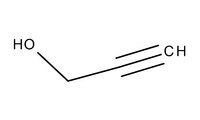807050 Sigma-Aldrich2-Propyn-1-ol
2-Propyn-1-ol for synthesis. CAS 107-19-7, pH 3 (500 g/l, H₂O, 20 °C).
More>> 2-Propyn-1-ol for synthesis. CAS 107-19-7, pH 3 (500 g/l, H₂O, 20 °C). Less<<Synonyms: Propargyl alcohol, Propinol, Ethynyl carbinol
Recommended Products
Overview
| Replacement Information |
|---|
Key Specifications Table
| CAS # | EC Number | Hill Formula | Molar Mass |
|---|---|---|---|
| 107-19-7 | 203-471-2 | C₃H₄O | 56.06 g/mol |
Pricing & Availability
| Catalog Number | Availability | Packaging | Qty/Pack | Price | Quantity | |
|---|---|---|---|---|---|---|
| 8070500250 |
|
Glass bottle | 250 ml |
|
— | |
| 8070501000 |
|
Glass bottle | 1 l |
|
— |
| Description | |
|---|---|
| Catalogue Number | 807050 |
| Synonyms | Propargyl alcohol, Propinol, Ethynyl carbinol |
| References |
|---|
| Product Information | |
|---|---|
| CAS number | 107-19-7 |
| EC index number | 603-078-00-X |
| EC number | 203-471-2 |
| Hill Formula | C₃H₄O |
| Molar Mass | 56.06 g/mol |
| HS Code | 2905 29 90 |
| Structure formula Image | |
| Quality Level | MQ200 |
| Applications | |
|---|---|
| Application | 2-Propyn-1-ol for synthesis. CAS 107-19-7, pH 3 (500 g/l, H₂O, 20 °C). |
| Biological Information |
|---|
| Dimensions |
|---|
| Materials Information |
|---|
| Toxicological Information | |
|---|---|
| LD 50 oral | LD50 Rat 56 mg/kg |
| Safety Information | |
|---|---|
| Categories of danger | flammable, toxic, corrosive, sensitizing, dangerous for the environment |
| Product Usage Statements |
|---|
| Storage and Shipping Information | |
|---|---|
| Storage | Store below +30°C. |
| Packaging Information |
|---|
| Supplemental Information |
|---|
| Specifications | |
|---|---|
| Assay (GC, area%) | ≥ 99.0 % (a/a) |
| Density (d 20 °C/ 4 °C) | 0.948 - 0.950 |
| Identity (IR) | passes test |
| Global Trade Item Number | |
|---|---|
| Catalog Number | GTIN |
| 8070500250 | 04022536393346 |
| 8070501000 | 04022536393353 |
Documentation
2-Propyn-1-ol SDS
| Title |
|---|
2-Propyn-1-ol Certificates of Analysis
| Product Number | Packaging | Specification | Lot Number |
|---|---|---|---|
| 8070500250 | Glass bottle | PDF Specification Document | |
| 8070501000 | Glass bottle | PDF Specification Document |












